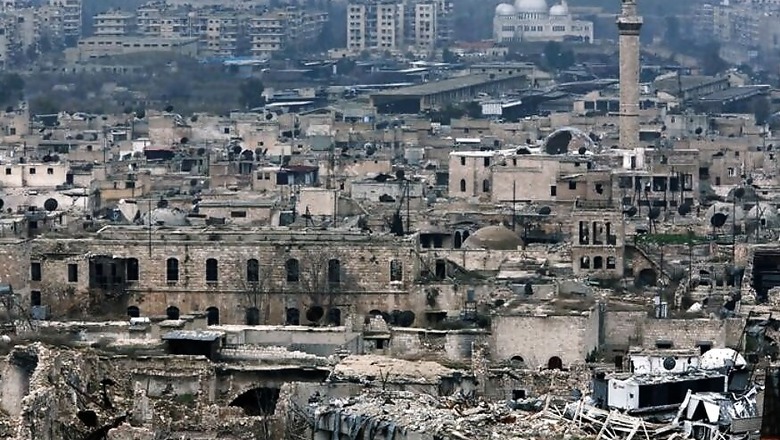
views
Aleppo: In the rubble-strewn square outside Aleppo's ancient citadel and under the scorched vaults of its covered souk, workmen are starting to mend the destruction of a war that has shattered the Syrian city's priceless historical heritage.
About 20 volunteers sorted through the debris in Khan al-Gumruk, one of the souk's great medieval inns, piling up the stones from a fallen archway that can be used in its restoration.
"I'm a son of this district. We're all from Aleppo and our priority is to work here. We've been at it for a month in this area since the fighters left," said Mohannad Hassari, a bearded 25-year-old.
About 30 percent of the Old City suffered "catastrophic" damage in the fighting that ended there in December, said Maamoun Abdulkarim, Syria's director general of antiquities.
Speaking to Reuters after his first visit to the city since the rebels were forced to surrender there, he said officials were working on a plan to save what they can.
The Aga Khan Development Network's cultural arm, which was behind a multi-million dollar restoration and urban development project around the Citadel and nearby souks a decade ago, said it was also looking at possible rehabilitation of the area.
Aleppo is one of the Middle East's great historic centres, its ancient Citadel and medieval mosques and souks among the region's finest buildings and a source of national pride - and tourist revenue - for Syria.
Today, the lingering smell of burning is everywhere in its Old City: under collapsed domes, in the soot-blackened souk and in the cracked masonry, broken glass and discarded bullet casings that litter the famous Umayyad Mosque.
A street vendor in gaudy folk costume accosted customers with paper cups of cardamom-spiced tea and coffee outside the Citadel. But the area's mood remained sombre compared with its bustling pre-war gaiety.
Many of the cafes that lined the area, in old buildings with arched facades, have been wrecked but a group of soldiers sat in one, warming their hands around a stove that billowed black smoke and listening to mournful Arabic music.
However, people are returning, some to live where homes are still habitable and others to salvage possessions from their shops. Many more simply want to enjoy places that were too dangerous to visit during the fighting.
In the Umayyad Mosque's courtyard a group of teenage boys huddled for a selfie in front of walls so peppered with bullets that it was hard to find a smooth patch of stone larger than the palm of one's hand. The 11th century minaret was destroyed by shelling in 2013.
Under the arches inside the mosque, an old man in a bulky greatcoat, woollen scarf wrapped around his head, stood sobbing in the dark near a shrine, a barricade of oil drums and sandbags still looming behind it.
FRONTLINE
When fighting erupted in Aleppo in 2012, a year after the rising against President Bashar al-Assad had begun elsewhere in Syria, rebels took its eastern districts and much of the Old City.
Intense clashes in 2012 and 2013 made the souks and the area around the Umayyad Mosque one of the fiercest front lines in Syria, pounded by artillery and air strikes.
Under the painted cupola of the Mamlouk throne hall in the Citadel, a heavy machine gun on a stand pointed towards a window and out across a wasteland of smashed buildings.
The Citadel, a dramatic fortress on a hill, stands at the centre of Aleppo, overlooking the city. It was held by the government but surrounded by rebel territory. The area to its south and west, near the Umayyad Mosque, is where the Old City suffered most damage.
One stretch of the covered souk is now a dark tunnel, pierced by beams of daylight from roof shafts, its entrance a mass of stones and its shops clogged with rubble and weeds.
Oil drums and sandbags, topped by a cushion in traditional fabric, gave fighters a firing position that commanded the souk corridor leading towards the Citadel.
"The memory of Aleppo is very symbolic," said Abdulkarim, Syria's antiquities director general. Restoration would meet the requirements of international bodies, he added, and no modern buildings would be put up in the Old City.
He said preservation of Syria's heritage should be treated separately from the political issues surrounding the war.
RESTORATION
Both sides in the continuing war have accused each other of targeting or damaging historical sites, which range from ancient cities, temples, mosques and castles to the more recent relics of Ottoman rule.
"Everybody realises we are working in difficult circumstances," said Ali Esmaiel, head of the Aga Khan Cultural Service in Syria, alluding to the fighting and other obstacles to saving Aleppo's heritage.
However, he said the charity was looking at a framework for the rehabilitation of the Old City and conservation of its historic monuments "as conditions and resources allow".
The charity worked from 1999 to 2012 on restoring the area around the Citadel, transforming it into a popular haunt for Aleppans and tourists and the site of concerts and other cultural activities.
But the fighting caused most to flee and its shops are now closed. At the Bab Antakia souk, Heitham Ghanam, a middle-aged trader in women's fashion accessories, was clearing rubble from his shop with his wife and daughter.
"We are waiting for the electricity to come back and for others to open their stores before we do," he said.
In Baron's Hotel, where Agatha Christie and T.E. Lawrence stayed, the elegant tiles of the grand lobby, smoking room and bar are hard to see in the unlit interior.
The only guests are three families of refugees from eastern Aleppo districts damaged in the fighting, one living in a room once occupied by Iraq's King Faisal.
At the top of the sloping causeway leading up to the Citadel's entrance, wide enough for horses to ride abreast, four soldiers scrolled through their phones under posters of Assad.
But many residents look forward to a time when the soldiers manning gun positions in the Citadel's museum and stringing laundry between the pillars of its Ayubid Mosque can be replaced by tourists.



















Comments
0 comment